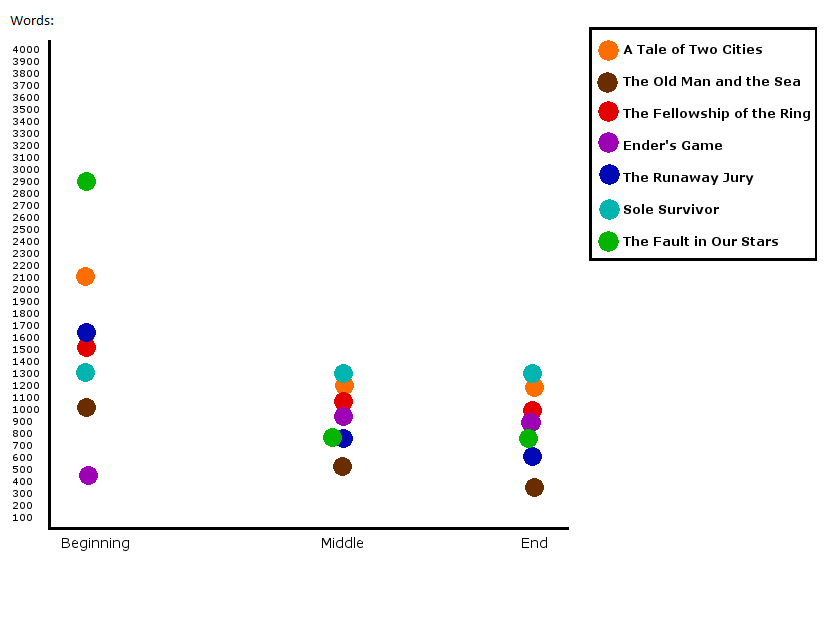Goodness knows how many times I’ve advised you to cut the fluff in your novel. But there is such a thing as cutting too much. If your goal is “as short as possible!” you might end up cutting more than the fluff—important stuff like character development and symbolism.
So wouldn’t it be better to aim for a specific length—like a range of words? But what range should we aim for? What are successful authors doing?
I decided to find out. I pulled seven novels off my shelves for my research. I tried to choose a good variety: the publishing dates ranged from 1859 to 2012, and genres included Literature, Suspense, Science Fiction and Fantasy.
This is NOT an exact science, people, so don’t take any of these findings as gospel truth. But I did find a few things that could be useful guidelines for us. Check out my lovely redneck graph showing (approximate) average words per scene for the beginning, middle and end of each book.:
The Takeaway
- All the books had a mix of longer and shorter scenes
- Longer scenes tended to appear toward the beginning, when the author was setting up character and setting
- Scenes were almost uniformly shorter (the action sped up) in the middle and end
- There were still occasional long scenes in the middles and ends of these books—usually scenes that introduced new characters or situations (more setup), or were action-packed climaxes
- One curious thing: though the number of words per page was different for each book, all the books seemed to have lots of scenes that were 2-4 pages long. This makes me wonder if publishers choose book sizes based on average scene length, to create the illusion of a certain pace. But I’m probably over-thinking it.
- We can be confident keeping most mid-to-end scenes between 300 and 1300 words. Earlier scenes can be longer.
Here are the detailed results and more than you ever wanted to know about how I got them:
What Counts as a Scene?
Scenes in novels are not always rigidly defined. I tried to measure scenes that were mostly action and/or dialogue, and avoided long chunks of exposition (which usually occur at the very beginning of novels, in the setup) and internal monologues (which are often used to transition from one scene into another). I didn’t feel these were proper “scenes,” as they occur inside the mind. Where action was tightly mixed with exposition (again, usually in opening scenes, especially the one in Runaway Jury), I counted it all. The hardest to measure were the middle scenes in Old Man and the Sea, which were an ambiguous mix of internal monologue and action.
Items that marked the beginning or end of a scene included:
- Chapter breaks
- The passage of time, indicated by:
- Formatting (*** or extra blank lines between paragraphs)
- Narration (“As the sun set,” “he awoke,” “two hours had passed,” etc.)
- Changes of setting
How I Measured
It might be more accurate to count every word in every scene in every book, but who has that kind of time? Instead, I looked at various scenes at the beginning, middle and end of each book, and multiplied the page numbers by the number of words on an average page (an average manuscript page is about 250 words, but paper and font sizes vary with published books, so I had to do sample page counts for each book—for instance, my copy of Old Man and the Sea has about 180 words per page, whereas my Fellowship of the Ring has over 500 words per page).
The Detailed Results
If I could confidently define one scene in the first few pages, I only measured that one (those that say “First ‘proper’ scene”). If heavy exposition or other factors made the opening scene less definite, I measured several scenes and counted a range (those that say “Opening Scenes”). Where you see a range followed by a parenthetical number, that means most scenes fell within the range, but I saw one that was the length in parenthesis. The marks you see on the graph are approximately mid-range.
A Tale of Two Cities by Charles Dickens (1859, Literature) WORDS/PAGE: 300 FIRST “PROPER” SCENE: 7 pages | 2100 words MIDDLE SCENES: 2-6 pages | 600-1800 words CLOSING SCENES: 2-6 pages | 600-1800 words The Old Man and the Sea by Ernest Hemingway (1952, Literature) WORDS/PAGE: 184 FIRST “PROPER” SCENE: 5.5 pages | 990 words MIDDLE SCENES: 2-4 pages | 360-720 words CLOSING SCENES: 1-3 pages | 180-540 words The Fellowship of the Ring by JRR Tolkien (1954, Fantasy) WORDS/PAGE: 500 FIRST “PROPER” SCENE: 3 pages | 1500 words MIDDLE SCENES: .5-4 pages | 250-2000 words CLOSING SCENES: 1-3 pages | 500-1500 words Ender’s Game by Orson Scott Card (1977, YA Sci Fi) WORDS/PAGE: 300 OPENING SCENES: .5-2.2 (8+) pages | 150 – 660 words (2400) MIDDLE SCENES: 2-4 (6) pages | 600-1200 (1800) words CLOSING SCENES: 2-4 pages | 600-1200 words The Runaway Jury by John Grisham (1996, Suspense) WORDS/PAGE: 300 FIRST “PROPER” SCENE: 5.5 pages | 1650 MIDDLE SCENES: 2-3 pages | 600-900 words CLOSING SCENES: 2 pages | 600 words Sole Survivor by Dean Koontz (1997, Suspense) WORDS/PAGE: 380 OPENING SCENES: 2-4.5 (8) pages | 760-1710 (3040) words MIDDLE SCENES: 2-5 pages (8.3) | 760-1900 (3154) words CLOSING SCENES: 2-4 pages (10) | 760-1520 (3800) words The Fault in Our Stars by John Green (2012, YA Literature) WORDS/PAGE: 250 OPENING SCENE(S): 10.33-13.33 pages | 2582-3332 words MIDDLE SCENES: 2-4 pages | 500-1000 words CLOSING SCENES: 2-4 pages | 500-1000 words



